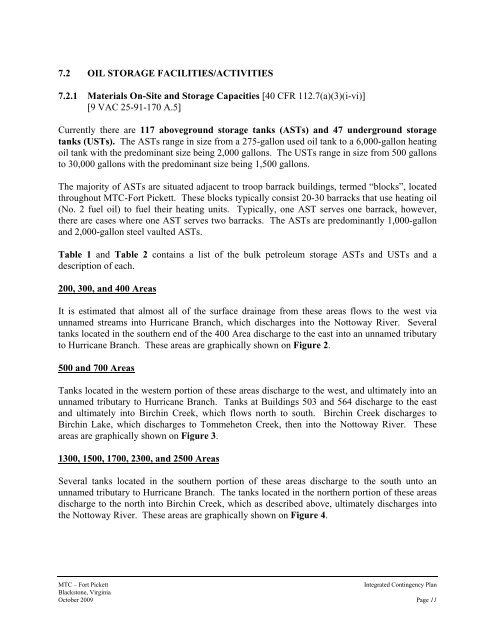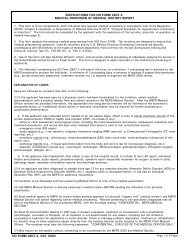INTEGRATED CONTINGENCY PLAN Maneuver Training Center
integrated contingency plan maneuver training center fort pickett ...
integrated contingency plan maneuver training center fort pickett ...
- No tags were found...
You also want an ePaper? Increase the reach of your titles
YUMPU automatically turns print PDFs into web optimized ePapers that Google loves.
7.2 OIL STORAGE FACILITIES/ACTIVITIES<br />
7.2.1 Materials On-Site and Storage Capacities [40 CFR 112.7(a)(3)(i-vi)]<br />
[9 VAC 25-91-170 A.5]<br />
Currently there are 117 aboveground storage tanks (ASTs) and 47 underground storage<br />
tanks (USTs). The ASTs range in size from a 275-gallon used oil tank to a 6,000-gallon heating<br />
oil tank with the predominant size being 2,000 gallons. The USTs range in size from 500 gallons<br />
to 30,000 gallons with the predominant size being 1,500 gallons.<br />
The majority of ASTs are situated adjacent to troop barrack buildings, termed “blocks”, located<br />
throughout MTC-Fort Pickett. These blocks typically consist 20-30 barracks that use heating oil<br />
(No. 2 fuel oil) to fuel their heating units. Typically, one AST serves one barrack, however,<br />
there are cases where one AST serves two barracks. The ASTs are predominantly 1,000-gallon<br />
and 2,000-gallon steel vaulted ASTs.<br />
Table 1 and Table 2 contains a list of the bulk petroleum storage ASTs and USTs and a<br />
description of each.<br />
200, 300, and 400 Areas<br />
It is estimated that almost all of the surface drainage from these areas flows to the west via<br />
unnamed streams into Hurricane Branch, which discharges into the Nottoway River. Several<br />
tanks located in the southern end of the 400 Area discharge to the east into an unnamed tributary<br />
to Hurricane Branch. These areas are graphically shown on Figure 2.<br />
500 and 700 Areas<br />
Tanks located in the western portion of these areas discharge to the west, and ultimately into an<br />
unnamed tributary to Hurricane Branch. Tanks at Buildings 503 and 564 discharge to the east<br />
and ultimately into Birchin Creek, which flows north to south. Birchin Creek discharges to<br />
Birchin Lake, which discharges to Tommeheton Creek, then into the Nottoway River. These<br />
areas are graphically shown on Figure 3.<br />
1300, 1500, 1700, 2300, and 2500 Areas<br />
Several tanks located in the southern portion of these areas discharge to the south unto an<br />
unnamed tributary to Hurricane Branch. The tanks located in the northern portion of these areas<br />
discharge to the north into Birchin Creek, which as described above, ultimately discharges into<br />
the Nottoway River. These areas are graphically shown on Figure 4.<br />
MTC – Fort Pickett<br />
Integrated Contingency Plan<br />
Blackstone, Virginia<br />
October 2009 Page 11
















